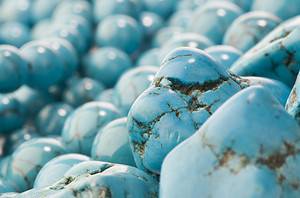Calcium carbonate is readily found around the world. It exists in nature as limestone, chalk, marble, and pure crystals. New calcium carbonate is being formed daily by animals, from microscopic sea creatures to ostriches, in the form of the shells they produce. People use this compound in a myriad of ways, from manufactured products and construction to medications and dietary supplements that make our lives better. In this article, we will discover the molar mass of calcium carbonate, take a closer look at its atomic structure, and learn about how this chemical compound is collected and used.

The Seven Sisters Chalk Cliffs in England are composed of compressed calcium carbonate.
©SHansche/iStock via Getty Images
The Molar Mass of Calcium Carbonate
Calcium carbonate, as a chemical compound, is defined as a pure substance. Pure substances include every defined chemical compound and each element on the periodic table. A pure substance has the same chemical composition throughout, from the smallest particle to the biggest amount. The smallest particles in elements are atoms, whereas the smallest particle of a compound is a molecule. Each pure substance has a specifically defined molar mass which influences the physical and chemical properties of the substance. The molar mass of calcium carbonate is 100.09 grams per mole.
What exactly is the molar mass of a substance? The molar mass is defined as the mass of one mole of a pure substance expressed in grams. In chemistry, a very specific number of particles, whether atoms or molecules, makes up a unit called a mole. That number, known as Avogadro’s number or Avogadro’s constant, equals approximately 6.022 × 1023 units. This constant, named for the Italian scientist, Amadeo Avogadro, is the same in every circumstance for every pure substance, and it is essential to understanding chemistry and how the world works.
Molar Mass vs. Atomic Mass
The atomic mass of an element or compound determines its molar mass. You can find the atomic mass of each element listed on the periodic table, usually just below the chemical symbol. The atomic mass of an element is measured scientifically, by taking account of all the known isotopes of the element. The average of these isotopes, weighted by their proportion as found in nature, equals the atomic mass for that element.
Each isotope of a specified element has a fixed number of protons. The number of protons equals the atomic number of the element. The number of neutrons in each isotope of the element varies. Every individual proton or neutron has a value of one atomic mass unit. But the mass of any number of electrons is so tiny that it can be disregarded. The atomic mass, therefore, of any isotope equals the number of protons it has plus the number of neutrons.
To better understand how the atomic mass of isotopes is measured, let’s look at carbon as an example. Carbon only has three different isotopes: carbon-12, carbon-13, and carbon-14. The carbon-12 isotope has six protons and six neutrons. Therefore, its atomic mass equals 12. Carbon-13 has six protons and seven neutrons, which results in an atomic mass of 13. Meanwhile, carbon-14, a radioactive carbon isotope used in dating organic materials, has six protons and eight neutrons. That gives it an atomic mass of 14. However, the calculated atomic mass of carbon does not equal 13, the straight average of these three numbers. That is because carbon-12 isotopes far outnumber carbon-13 and carbon-14 in nature. So, the atomic mass must skew in favor of carbon-12, taking into account its higher representation. The atomic mass of carbon, then, is 12.011 atomic mass units.
Calculating the Molar Mass of Calcium Carbonate
You can easily determine the molar mass of an element once you know its atomic mass. You simply express the element’s atomic mass in grams. The mass of one mole of atoms of an element equals the atomic mass in grams.
This same concept applies to compounds. Compounds contain two or more atoms of the same or different elements in each molecule. To find the atomic mass of a compound, just add up the atomic masses of all the atoms in the molecule. The total equals the compound’s atomic mass.
Calcium carbonate, CaCO3, has five atoms in each molecule. It has one calcium atom, one carbon atom, and three oxygen atoms. Therefore, one mole of calcium carbonate molecules would have one mole of calcium atoms, one mole of carbon atoms, and three moles of oxygen atoms. To find the mass of one mole of calcium, just convert the atomic mass of calcium to grams. One mole of calcium has a mass of 40.08 grams. One mole of carbon has a mass of 12.01 grams. And each mole of oxygen has a mass of 16.00 grams. Adding the mass of the five atoms in this compound gives a total of 100.09 grams as the molar mass of calcium carbonate.
Atomic Structure of Calcium Carbonate
Calcium carbonate, CaCO3, is an inorganic salt, much like sodium chloride, NaCl or calcium chloride, CaCl2. Many different types of salts exist. These compounds have one or more cations, or positively charged ions, bonded ionically to one or more anions, or negatively charged ions. The net charge of a salt equals zero. Salts often combine positively charged ions from Group 1 of the periodic table, the alkali metals, or Group 2, the alkaline earth metals, with negatively charged non-metals, such as the Group 17 halides or polyatomic ions, such as the CO32- carbonate ion.
Both sodium chloride and calcium carbonate are salts that are composed of two ions. Sodium chloride contains the positively charged sodium ion, Na+, and the negatively charged chlorine ion, Cl–. You might be wondering how the two compounds can both be inorganic salts when calcium carbonate contains so many atoms. Well, calcium carbonate also has just two ions: a positively charged calcium ion, Ca2+, and a negatively charged polyatomic carbonate ion, CO32-.
Polyatomic ions are made of two or more atoms that work together as one unit. They function just like other single-atom ions. The carbonate ion has four atoms all working together with a net charge of -2.
Bonding to Form Compounds
When ions join together to form compounds, each one seeks to fill its orbitals with enough electrons to reach a stable configuration. This stable configuration usually gives each atom in the compound a configuration equal to that of the nearest noble gas, or Group 18 element.
Ionic bonding, the type used in the formation of salts like calcium carbonate, involves the giving and taking of electrons. This is different than the sharing of electrons as seen in covalent bonding, as seen in molecules like carbon dioxide. Many compounds use covalent bonding and share electrons to reach the desired noble gas configuration, but calcium carbonate and other salts use ionic bonding to reach that stable configuration.
Calcium, a metal from the Group 2 alkaline earth metals group, has two electrons in its outer shell. The easiest way for a calcium ion, Ca2+, to reach the stable configuration of the nearest noble gas, argon, is to give away its two extra electrons. Carbonate, a polyatomic ion with a -2 charge, needs two extra electrons to finish filling up its outer shells. It can reach its desired configuration by accepting two electrons.
Calcium Carbonate Bonds
When a calcium ion gives the two electrons from its outer shell to a polyatomic carbonate ion, an ionic bond forms resulting in calcium carbonate. Each calcium ion, with its +2 charge, can bond with one carbonate ion, with a -2 charge, to form a molecule with a neutral charge. The following chemical equation shows this reaction.
Ca2+ + CO32- → CaCO3
Interestingly, calcium carbonate contains both ionic and covalent bonds. The bond between the calcium ion and the carbonate ion is ionic. However, the bonds between the carbon and oxygen atoms that make up the polyatomic carbonate ion are actually covalent, meaning that they share electrons instead of trading them.
Calcium Carbonate in Nature
Calcium carbonate makes up roughly 4 percent of the Earth’s crust. It exists in many forms. Most calcium carbonate is found in deposits that were formed long ago when creatures in the sea died or shed their shells. Animals such as birds and shellfish process calcium with oxygen and carbon to form eggshells, seashells, snail shells, and coral reefs from calcium carbonate.

Coral reef is composed of calcium carbonate.
©iStock.com/johnandersonphoto
These important sources of calcium carbonate sunk long ago and formed sediment, which under pressure formed rocks such as limestone, chalk, and marble. Calcium carbonate can form pure crystals in at least three different structures: calcite, aragonite, and vaterite. If you have ever visited a limestone cave, you’ve seen calcium carbonate in the wild. The stalactites and stalagmites in these caves develop when water leaches through the limestone and deposits calcium carbonate in beautiful formations.

The structures in a limestone cave are made of calcium carbonate.
©leungchopan/iStock via Getty Images
Companies obtain calcium carbonate in multiple ways. They may dig or carve solid calcium carbonate from the ground. Or they can crush natural sources such as oyster shells. They can even precipitate calcium carbonate by converting limestone into calcium oxide and carbon dioxide, then reacting those components under controlled conditions to produce a salt of higher purity than that found in nature.
Common Uses of Calcium Carbonate
Calcium carbonate has many important and fascinating uses. Listed below are some of the most common uses of this compound.
Construction
You probably already know about calcium carbonate’s use as a building material in the form of high-end marble countertops or travertine floors. However, this compound has a multitude of other uses in the construction industry. Lime, derived from calcium carbonate, plays a part in the manufacture of both glass and steel. Calcium carbonate is also used in concrete, cement, and mortar. Many construction companies also use calcium carbonate to help neutralize acid in the water and soil and reduce the environmental impact of their projects.

Bright paints, caulk, and other construction materials contain significant amounts of calcium carbonate.
©Visivasnc/iStock via Getty Images
Manufactured Goods
Paper manufacturers use calcium carbonate as a filler, a coating, and an important ingredient in many different products. Calcium carbonate has a bright, sharp, white color that proves useful for pigments in paints, paper, and more. Pick up a modern textbook and look at the glossy pages. The coating that makes them so shiny, white, and easily printed may very well be calcium carbonate. Yes, your textbooks are extra heavy because the pages are coated in a thin film made of rock!
When used in paint, this versatile compound adds brightness and may account for up to 30 percent of matte formulations. It also finds uses in sealants such as caulk and other adhesives. Calcium carbonate accounts for a significant amount of filler in a range of plastics. It also lends its sharp white color as a useful pigment in these products. It is even used in making breathable films found in products such as diapers, medical products, and even roofing materials.
Dietary Supplements
Calcium carbonate can be used as a dietary supplement to provide users with the important mineral, calcium. Some people, due to medical conditions, are unable to absorb enough calcium through diet alone. Calcium carbonate supplements provide extra calcium in an absorbable form that most people are able to tolerate well. The compound also provides much-needed calcium to chickens and other poultry in the form of dietary supplements and additives to their feed.
Medical Uses
One of the most important uses of calcium carbonate is in the medical field. We need calcium in order for our bodies to function properly. Many people get enough calcium from the foods they eat, particularly dairy and leafy greens. However, people often need extra calcium for healthy bone development and growth. Research has shown that calcium carbonate, administered before puberty, can positively affect the growth of adolescents. Calcium carbonate can also be prescribed to treat osteoporosis, renal failure, and of course, it can be used over the counter to treat acid indigestion.
Dangers of Calcium Carbonate
You can overdose on calcium carbonate, and the effects may be serious. In our homes, the most likely source of a calcium carbonate overdose would be found in the medicine cabinet. Many antacids and vitamin or mineral supplements contain calcium carbonate. Taking too much of this drug can result in an overdose of calcium, which may impair kidney function, dangerously increase the pH of the blood, cause nausea and vomiting, and in some cases even an irregular heartbeat. An overdose of this kind can also cause temporary changes in mental state, including confusion, depression, and irritability. Long-term overuse of this drug is more likely to cause problems than acute poisoning, but if you suspect an overdose call poison control immediately.
Other Calcium Compounds
Let’s take a look at several other calcium salts. The compounds below all include one or more positively charged calcium cations and one or more negatively charged anions. The larger the mass of the negatively charged ion, the larger the molar mass of the compound will be.
| Compound Name | Chemical Formula | Molar Mass | Primary Uses |
|---|---|---|---|
| Calcium carbonate | CaCO3 | 100.01 g/mol | Construction, food, medical, cosmetic |
| Calcium chloride | CaCl2 | 110.98 g/mol | De-icing, food, laboratory, medical |
| Calcium sulfate | CaSO4 | 136.14 g/mol | Construction, food, dentistry |
| Calcium phosphate | Ca3(PO4)2 | 310.18 g/mol | Food additive, nutritional supplement |
| Calcium citrate | Ca3(C6H5O7)2 | 498.43 g/mol | Specialized nutritional supplement |
Conclusion
As you have learned, calcium carbonate is an important chemical compound that occurs naturally in our world. This salt has a more complex structure than diatomic salts but is still composed of a single positively charged cation and a negatively charged polyatomic anion. Calcium carbonate has many uses, from construction and manufacturing to dietary supplements and medicine. This highly versatile compound is easily found in nature and can also be made in the lab. Our world truly would not be the same without it.
Thank you for reading! Have some feedback for us? Contact the AZ Animals editorial team.








